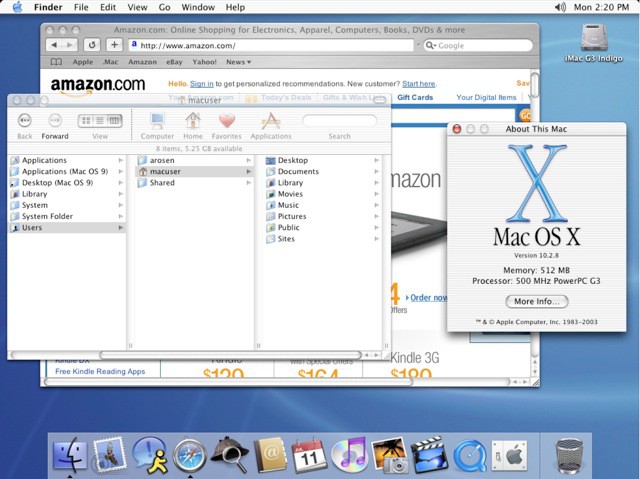Mac Os X 10.0 Cheetah Iso


• • Source model (with components) March 24, 2001; 16 years ago ( 2001-03-24) 10.0.4 / June 22, 2001; 16 years ago ( 2001-06-22) Platforms type () (APSL) and Apple (EULA) Preceded by Succeeded by Official website at the (archived June 29, 2001) Support status Unsupported as of 2003 Mac OS X version 10.0 ( Cheetah) is the first of, desktop and server. Mac OS X 10.0 was released on March 24, 2001 for a price of US$129.
It was the successor of the and the predecessor of. Mac OS X 10.0 was a radical departure from the and was Apple’s long-awaited answer for a next generation. Dasar Awam Di Malaysia Pdf.
Mac OS X version 10.0 (code named Cheetah) is the first major release of Mac OS X (later named OS X and then macOS), Apple’s desktop and server operating system. Download Mac OS X Lion. Download Apple MAC OS X Leopard (10.5) ISO free. Download Mac OS X Leopard (10.5) for free. Mac OS X Leopard released on 26 October 2007.
It introduced a brand new code base completely separate from 's, as well as all previous Apple operating systems. Mac OS X introduced the new core and a completely new system of memory management. Cheetah proved to be a rocky start to the Mac OS X line, plagued with missing features and performance issues, although it was praised for still being a good start to an operating system still in its infancy, in terms of completeness and overall operating system stability. Unlike releases of Mac OS X 10.2 to 10.8, the cat-themed code name was not used in marketing the new operating system.
Contents • • • • • • • • System requirements [ ] The system requirements for Mac OS X 10.0 were not well received by the Macintosh community, as at the time the amount of standard with Macintosh computers was 64 (MB), while the Mac OS X 10.0 requirements called for 128 MB of RAM. In addition, upgrade cards, which were quite popular for pre-G3 computers, were not supported (and never officially have been, but can be made to work through third-party utility programs). Additionally the new operating system required more hard drive space, causing longer boot times. • Supported Computers:,,,,,,, • RAM: • 128 MB (unofficially 64 MB minimum) • Hard Drive Space: • 1,500 MB (800 MB for the minimal install) Features [ ]. This article is in a list format that may be better presented using. You can help by converting this article to prose, if.
Is available. (April 2017) • — the Dock was a new way of organizing one's Mac OS X applications on a user interface, and a change from the classic method of Application launching in previous Mac OS systems. • — the Open Source Foundation Mach kernel was part of the for Mac OS X, and was one of the largest changes from a technical standpoint in Mac OS X. • — the Terminal was a feature that allowed access to Mac OS X's underpinnings, namely the Unix core. Mac OS had previously had the distinction of being one of the few operating systems with no at all. • • — new on-board word processor, replacement to. • Full support, a long-awaited feature on the Mac.
• (create PDFs from any application) • UI — new • Built on, a operating system. • • • Support for and • — desktop and web search engine. The Mummy Returns Ps2 Iso. Pc Logo Turtle For Windows 10. • — memory protection so that if an application corrupts its memory, the memory of other applications will not be corrupted.
Limitations [ ] • File-sharing client — The system can only use TCP/IP, not, to connect to servers sharing the. It cannot use to connect to or servers. • File-sharing server — As a server, the system can share files using only the (over ),,, and. Criticism and problems [ ] While the first Mac OS X release was an advanced operating system in terms of its technical underpinnings and in relation to its brand new code-base, and was praised for its Aqua interface, Mac OS X 10.0 was heavily criticized. There were three main reasons for criticism: • Interface Responsiveness — The brand-new Aqua interface was sluggish at best. It was heavily criticized for its slow application launch speed and user interface response speed. The interface response times compared to earlier Apple operating systems showed that Mac OS X still had a long way to go in terms of interface performance.
Comments are closed.